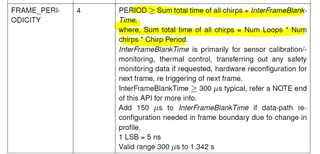Hi,
I'm posting this inquiry in behalf of customer, below is the details
"I just got a little bit confused with a detail of the chirp configuration for the TIDEP-01012. In the LUA-Script is a parameter called Inter_Frame_Interval. I got a little bit confused, and I am wondering what the parameter actually defines.
I programmed a chirp with the following parameters:
Start Frequency 77 GHz
Slope: 65.854 MHz/us
Idle Time: 3 us
ADC Start Time: 3us
ADC Samples: 512
Sample Frequency: 22500 kHz
Ramp End Time: 28us
Chirps per Loop: 1
Frames (Master/Slave): 65000
InterFrame Interval (IFI): 2.5ms
1. Which period is the IFI actually defining with respect to the chirp? Based on the document Programming Chirp Parameters (https://www.ti.com/lit/an/swra553a/swra553a.pdf?ts=1629095856641), the IFI would be time (a) as shown in the figure below. But is this really correct, or is it not rather the time (b)? If it is (a) then the acquisition frequency in my case above would not be 400 Hz but
1000/(IFI+t_frame)
with IFI = 2.5ms and t_frame = t_idle + t_rampEnd = 3 + 25us
leading to 1000/(2.5+0.028) = 395.57 Hz?
2. In the e2e-Forum, it was once mentioned that the minimum time for the IFI is Chirp Duration + 200us (https://e2e.ti.com/support/sensors-group/sensors/f/sensors-forum/757384/awr1243-what-is-the-lower-limit-of-frame-periodicity/2798332?tisearch=e2e-sitesearch&keymatch=framePeriodicty#2798332). I used then the following equation to calculate the minimum IFI: ( N_TX * (Time_Idle + Time_RampEnd) * N_Chirps ) + 300us, which would we 0.672ms for my settings. With this value/calculation, I will not receive an error in MMWAVE Studio, and I could acquire the data. However, I observe that I am rarely able to acquire all acquisitions (e.g. 65000) for short IFI. Especially if they are smaller than 1ms. Is my assumption true that it is not possible to constantly acquire data with a frequency higher than 1000 Hz? What are the limiting factors?
"
Thank you in advance.
Regards,
Maynard



